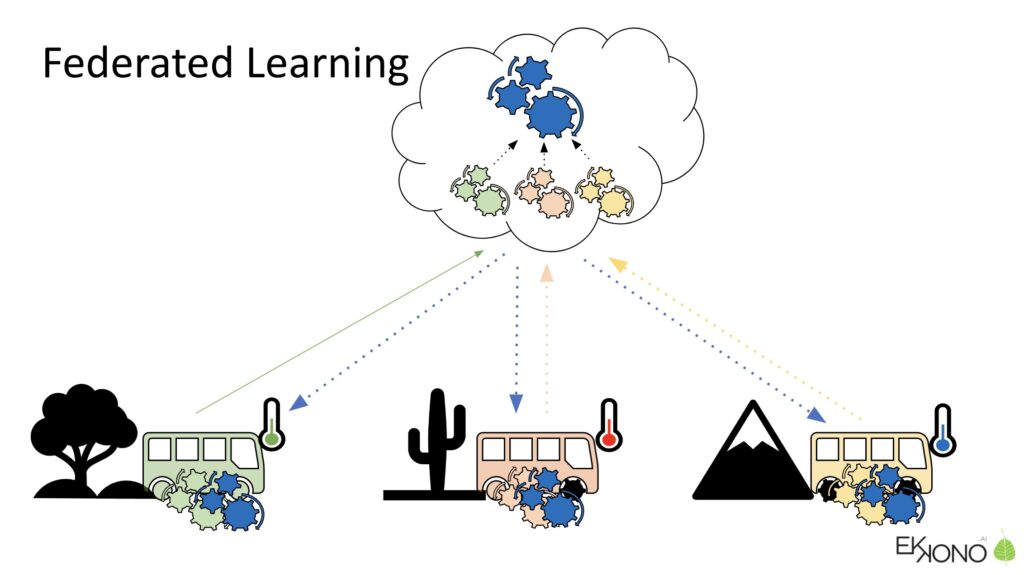Written by Gustav Gärdesmed , Team Lead Cloud Development
In the world of Internet of Things (IoT), the pace of innovation never slows down. As the lead backend architect of our latest venture, I’m thrilled to introduce you to Synthesis, a project that is the new extended arm of Ekkono’s SDK, letting you have full control of your models.
Federated Learning: Collective Insights, Enhanced Privacy

At the heart of Synthesis is federated learning a technique that trains a machine learning model across multiple edge devices processing local data, without exchanging them. This method supports privacy-preserving data analysis, as the data never leaves its original location. Instead, federated learning leverages the power of collaboration by sending model updates to a central server where they are combined and integrated into a global model. This updated model is then sent back to all participating devices.
This process ensures that sensitive data remains secure on local devices, reducing the risks associated with data breaches. It also minimizes the need for data transfer, which can be beneficial in scenarios where data connectivity is limited or expensive. Federated learning is particularly well-suited for IoT environments where numerous devices generate vast amounts of data that can be leveraged to enhance model accuracy and performance while adhering to privacy regulations. In the context of Synthesis, federated learning allows for continuous, real-time model improvement across all devices without compromising user confidentiality.
💡 Read our white paper about Federated Learning if you want to get more details about how Federated Learning works!
In other words, federated learning is a perfect match when you are using incremental machine learning on edge devices. But how will you realize it into your own solutions? This article will tell you how easily you will be able utilize federated learning in production using Ekkono’s new platform we are calling Synthesis!
Navigating Deployment Complexities: The Need for Robust Architecture
The deployment of federated learning solutions requires navigating a complex landscape full with technical and operational challenges. One of the foremost issues is ensuring robust data privacy, which necessitates advanced encryption and secure communication channels to protect data as it travels across devices. Additionally, the diversity in device capabilities and network conditions calls for an architecture that can efficiently manage resource disparities and ensure uniform model training and updates. This demands a flexible and scalable infrastructure that can adapt to varying computational resources and data volumes, ensuring that the learning process is seamless and efficient across all nodes in the network.
What Does This Mean for You?
If you’re thinking about using Synthesis, here’s some good news: you won’t have to send us your data or models. You can set up Synthesis right in your own system. This means you keep full control over your data.

Microservices Architecture: Scalable, Manageable, and Robust
Synthesis runs as microservices operating on a Kubernetes cluster.
So the process of enabling Synthesis in your system is quite minimal. The only thing you need to prepare is a Kubernetes cluster and a Postgres database. The services are easily deployed with our Helm charts.
We’ve broken down the system into key components:
- API Server: The API server facilitates interactions with the database and model registry, acting as the gateway to the Synthesis ecosystem.
- Analytics Service: The Analytics Service handles all computational aspects, analyzing models and providing actionable insights.
- Controller: The controller manages the business logic and ensures seamless communication between the API server and the Analytics Service. When you integrate your system with Synthesis, it is with the controller you are connecting to. Here you typically make requests to the controller with a classical RPC and/or an HTTP request.
Streamlining Complex Deployments
Synthesis architecture addresses the key challenges of federated learning deployments through its robust, scalable microservices design. By leveraging a Kubernetes cluster, Synthesis ensures a flexible and resilient environment where services can be easily managed and scaled according to the network and device capabilities. The use of Helm charts for deployment streamlines the setup process, reducing the technical overhead and speeding up the implementation. This architecture not only simplifies the management of device heterogeneity and data privacy but also enhances the overall efficiency of the federated learning process, allowing businesses to harness the power of collective insights without compromising on security or control.
The Road Ahead
As we embark on this exciting journey with Synthesis, we invite you to join us. Let’s synthesize success together.
